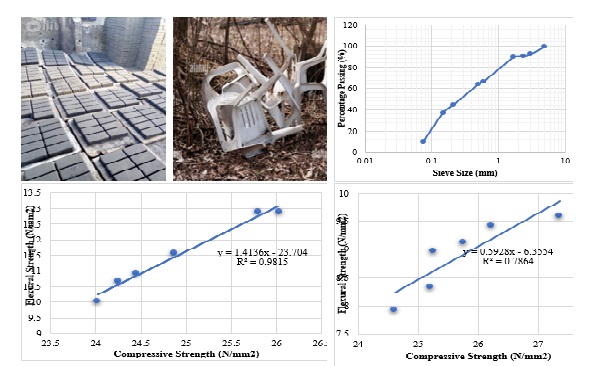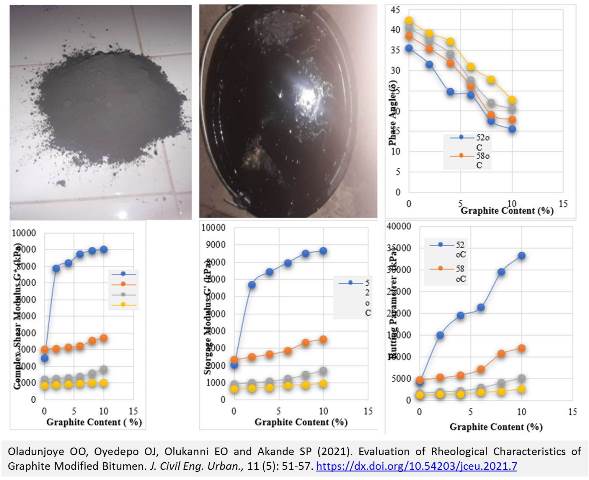Previous issue | Next issue | Archive
Volume 11 (5); 25 September, 2021
Strength Characteristics of Concrete with Waste Polypropylene as Modifier for Pavement Construction
Oyedepo OO, Olukanni EO and Arowolo TR.
J. Civil Eng. Urban., 11(5): 42-50, 2021; pii:S225204302100006-11
DOI: https://dx.doi.org/10.54203/jceu.2021.6
Abstract
The demand for a better performing pavement and the need to convert the ever-growing polymer waste into beneficial use necessitated the need to develop and characterize a polypropylene modified concrete for use in pavement construction. This research focuses on characterizing the strength of concrete produced with waste polypropylene waste as modifiers for pavement construction. The materials used in this research are fine and coarse aggregates, cement and polypropylene waste chairs (PWC). Tests were performed on the aggregate and fresh concrete to determine their suitability and characteristics for use in concrete for pavement. Two concrete grades 1:2:4 and 1:3:6 was produced into 200 mm, 400 mm and 500 mm long paving stones on which compressive and flexural tests were performed. Results obtained showed that 400 mm 1:2:4 grade concrete has the highest compressive strength of 27.36 N/mm2 at 10% polypropylene composition. The 200 mm 1:2:4 concrete grade paving stone with 10% polyprpopylene composition has the highest flexural strength of 12.90 N/mm2. The 200 mm at 10% polypropylene composition correlation coefficient has that the highest value of 0.98 which better explains the compression-flexural strength relationship and validates the 200 mm length at 10% polypropylene composition paving stone as the most adequate length of paving stone for pavement construction. It was concluded that the 200 mm long 1:2:4 concrete grade paving stone at 10% polypropylene composition is the best length of paving stone that can give an adequate flexural strength which is the most important requirent in concrete pavement requirement.
Keywords: Waste Polypropylene, Concrete, Compressive Strength, Flexural Strength, Paving Stones, Pavement
[Full text-PDF] [ePub] [XML] [Export citation to RIS-EndNote] [Export from Eprints] [How to Cite]
Evaluation of Rheological Characteristics of Graphite Modified Bitumen
Oladunjoye OO, Oyedepo OJ, Olukanni EO and Akande SP.
J. Civil Eng. Urban., 11(5): 51-57, 2021; pii:S225204302100007-11
DOI: https://dx.doi.org/10.54203/jceu.2021.7
Abstract
The level of performance of asphalt concrete has a close relationship with the properties of bitumen used. This research evaluates the rheological parameters of graphite modified bitumen. Index properties tests were conducted on bitumen and graphite to determine their suitability. Dynamic viscosity and dynamic shear rheometer were conducted on bituminous binder modified with four different proportion of graphite ranging from 2% to 10% by bitumen weight. Dynamic viscosity test was conducted on bitumen and graphite modified bitumen at temperature of 1350C and 1650C using Brookfield Viscometer. The rheological properties are centered on phase angle (δ) and complex shear modulus (G*) which were determined on bitumen and graphite modified bitumen at temperature ranging from 520C – 700C at 10 rad/s frequency using Dynamic Shear Rheometer in accordance with ASTM D7175-15. The storage modulus (G'), loss modulus (G") and rutting parameters were then evaluated from phase angle and complex shear modulus. The bitumen and graphite modified bitumen showed that graphite modified bitumen has the highest complex shear modulus and rutting parameter of 8984 (kPa) and 33387 (kPa) at 10% graphite content. The results of viscosity helped to determine the mixing and compaction temperatures. Dynamic shear rheometer test results determined the elastic and viscous behaviour at various temperature. The higher the complex shear modulus and rutting parameter the stiffer the binder will resist deformation and rutting.
Keywords: Graphite, Bitumen, Rheology, Characteristics
[Full text-PDF] [ePub] [XML] [Export citation to RIS-EndNote] [Export from Eprints] [How to Cite]
Previous issue | Next issue | Archive
This work is licensed under a Creative Commons Attribution 4.0 International License (CC BY 4.0)![]()


